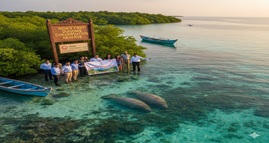28 September, 2025
India’s First Dugong Conservation Reserve Receives Official Recognition from IUCN
Sun 28 Sep, 2025
Context:
- The International Union for Conservation of Nature (IUCN) officially recognized India’s first Dugong Conservation Reserve during the World Conservation Congress 2025.
Dugong Conservation Reserve: Establishment and Details
Establishment:
- It is India’s first Dugong Conservation Reserve, notified on 21 September 2022 by the Government of Tamil Nadu under the Wildlife (Protection) Act, 1972.
- It covers the northern Palk Bay region of Thanjavur and Pudukottai districts.
- Area: 448.34 sq. km.
Ecological Significance:
- The region hosts more than 12,250 hectares of seagrass meadows, which are the primary food source for Dugongs (Dugong dugon).
- These meadows provide shelter not only for Dugongs but also for fish, crabs, prawns, and other marine species, forming the livelihood base of local fishermen.
Conservation Efforts:
- Innovative methods such as bamboo and coconut rope frames have been adopted for restoring seagrass meadows.
- Between 2021–2025, 16 Dugongs were rescued and released.
- Local communities have been sensitized, leading to increased reporting to the Forest Department in case of accidental captures.
- Additionally, an International Dugong Conservation Centre is being established at Manora, Thanjavur.
Geographic Context:
- Palk Bay is a shallow bay that provides an ideal habitat for Dugongs.
- In India, Dugong populations are mainly found in the Palk Bay, Gulf of Mannar, Gulf of Kutch, and the Andaman & Nicobar Islands.
Dugong Species: Features and Conservation Status
Dugong (Dugong dugon):
- A rare marine mammal often called the “sea cow.”
- Mainly found in tropical and subtropical marine waters.
Classification:
- Scientific name: Dugong dugon
- Family: Dugongidae
- Order: Sirenia
Physical and Lifestyle Characteristics:
- Length: ~2.5–3.5 meters
- Weight: ~250–400 kg
- Herbivore: Feeds primarily on seagrass
- Swimming: Moves slowly, usually near the surface
- Reproduction: Gestation of 13–15 months; usually one calf born
- Distribution: Found in tropical and subtropical waters such as the Indian Ocean and Western Pacific.
-
- In India: Palk Bay, Gulf of Mannar, Gulf of Kutch, Andaman & Nicobar Islands.
- Reproduction specifics: Sexual maturity at 9–10 years; birth interval of 3–5 years; population growth rate max ~5% per year (very slow).
Conservation Status:
- IUCN Red List: Vulnerable
- CITES: Appendix I (trade prohibited)
- Wildlife (Protection) Act, 1972: Schedule I (highest protection)
- CMS (Convention on Migratory Species): Appendix II; India is a signatory to the Dugong MoU since 2008
- Population in India: Estimated 150–200 (mainly concentrated in Palk Bay)
International Union for Conservation of Nature (IUCN)
- Full Name: International Union for Conservation of Nature
- Founded: 5 October 1948, Fontainebleau, France
- Headquarters: Gland, Switzerland
- Type: Non-governmental, international organization
- Objective: To ensure conservation of nature and sustainable use of natural resources
- Membership: ~1,400 government and non-government organizations from over 170 countries
- Employees: ~900 full-time staff working worldwide
- Work Areas: Nature conservation, biodiversity protection, sustainable resource management, development initiatives
- Key Activities: Data collection and analysis, research, regional conservation projects, policy support, education, and awareness campaigns
- Major Achievement: IUCN Red List of Threatened Species – the world’s most authoritative source on the status of threatened species
Other Facts:
- IUCN World Conservation Congress is held every four years where members vote on global conservation agendas.
- IUCN acts as an observer at the United Nations and supports various international environmental treaties.
- Provides advice and collaboration to governments, businesses, and stakeholders on environmental conservation.
Note: At the IUCN World Conservation Congress 2025 (Abu Dhabi), India’s Dugong Conservation Reserve received recognition with 98% government support and 94.8% NGO support, highlighting its global importance.
IUCN World Conservation Congress
- The largest global platform for environmental conservation and sustainable development.
- Held: Every four years
- Participants: Governments, civil society, indigenous groups, businesses, academia, and decision-makers
- Objectives:
-
- Define the global conservation agenda
- Strengthen environmental governance
- Promote nature-based solutions to environmental challenges
- Ensure equitable distribution of conservation responsibilities
Three Main Components:
- Forum: The largest marketplace of knowledge and innovation related to conservation and sustainable development, covering economic, social, scientific, and technological aspects.
- Exhibition: Members, businesses, partners, and academic institutions showcase pavilions and research work.
- Members’ Assembly: The highest decision-making body of IUCN where members vote on conservation and sustainable development issues.
Recent Congress (2025):
- Venue: Abu Dhabi, United Arab Emirates
- Theme: Transformative Conservation Power


















